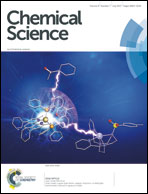Design of template-stabilized active and earth-abundant oxygen evolution catalysts in acid†
Abstract
Oxygen evolution reaction (OER) catalysts that are earth-abundant and are active and stable in acid are unknown. Active catalysts derived from Co and Ni oxides dissolve at low pH, whereas acid stable systems such as Mn oxides (MnOx) display poor OER activity. We now demonstrate a rational approach for the design of earth-abundant catalysts that are stable and active in acid by treating activity and stability as decoupled elements of mixed metal oxides. Manganese serves as a stabilizing structural element for catalytically active Co centers in CoMnOx films. In acidic solutions (pH 2.5), CoMnOx exhibits the OER activity of electrodeposited Co oxide (CoOx) with a Tafel slope of 70–80 mV per decade while also retaining the long-term acid stability of MnOx films for OER at 0.1 mA cm−2. Driving OER at greater current densities in this system is not viable because at high anodic potentials, Mn oxides convert to and dissolve as permanganate. However, by exploiting the decoupled design of the catalyst, the stabilizing structural element may be optimized independently of the Co active sites. By screening potential–pH diagrams, we replaced Mn with Pb to prepare CoFePbOx films that maintained the high OER activity of CoOx at pH 2.5 while exhibiting long-term acid stability at higher current densities (at 1 mA cm−2 for over 50 h at pH 2.0). Under these acidic conditions, CoFePbOx exhibits OER activity that approaches noble metal oxides, thus establishing the viability of decoupling functionality in mixed metal catalysts for designing active, acid-stable, and earth-abundant OER catalysts.



 Please wait while we load your content...
Please wait while we load your content...